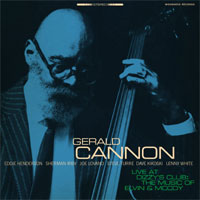Gerald Cannon • Live at Dizzy's Club: The Music of Elvin & McCoy Woodneck Records GC-001
Gerald Cannon's Live at Dizzy's Club introduced me to a previously unknown bassist who is also a record-label owner, teacher, and fine-art painter. Cannon, 66 years old this year, was born in Racine, Wisconsin, and was handed an electric bass at the age of ten. Soon after, he began playing in his father’s gospel ensemble, The Gospel Expressions. Years later, while attending the University of Wisconsin, he met bassist Milt Hinton, an encounter that would change Cannon’s life path and turn him toward the acoustic upright string bass. After years of studying that instrument at the Wisconsin Conservatory of Music in Milwaukee, he headed east to New York City. He played bass wherever he could, be it in the subway or at the occasional gig at the renowned Blue Note jazz club. He soon became a go-to bassist for several legendary jazz performers, including Art Blakey, Dexter Gordon, Cedar Walton, Jimmy Smith, Frank Foster and Eddie Harris. One evening, while Cannon played in a club, trumpeter Roy Hargrove noticed and recruited him. He remained with Hargrove for the next seven years, where he appeared at jazz festivals worldwide. After leaving the Hargrove band, Cannon became bassist for legendary drummer Elvin Jones, a position he held until Jones’s passing in 2004. During his career, Cannon has worked with countless A-list jazz artists, most notably as bassist and musical director for pianist McCoy Tyner’s trio. Besides remaining active on the New York jazz scene, Cannon maintains academic credentials: Jazz Bass instructor at New York’s famed Juilliard School of Music and, for the past two years, Associate Professor of Jazz Bass at Oberlin College & Conservatory in Ohio. He continues to hold master classes throughout the world. He formed Woodneck Records over twenty years ago. As if all that were not enough, he is also an accomplished painter, with his canvases viewable on his website. For this album, his third on his Woodneck Records label, Cannon has assembled a tight seven-man ensemble consisting of alto sax, tenor sax, trumpet, trombone, piano, drums and, of course, upright bass. Each musician is an established, accomplished performer with an impressive pedigree, yet I’m embarrassed to admit that I know of only three of the musicians involved: tenor saxophonist Joe Lovano, trumpeter Eddie Henderson, and drummer Lenny White. The others, Sherman Irby on alto sax, Dave Kikoski on piano, and Steve Turre on trombone, were not on my musical radar. All live in close proximity to New York City, the hub for live music on the East Coast, and all play their butts off on this outstanding live recording of post-bop modern jazz captured over two nights and four sets at Jazz at Lincoln Center’s popular Dizzy’s Club. Of the eight tunes spread over the four sides of this double-LP set, two were written by Jones, five by McCoy Tyner and one by Cannon. Elvin Jones’ composition “EJ’s Blues” opens the proceedings, and it’s a barn burner featuring spirited solos by all and signaling the high level of music to come. Cannon's "Three Elders" finds Henderson reaching for the Harmon mute to deliver a pensive solo, followed by Lovano's soulful musings, soon returning to the muted trumpet and more of Lovano's lamentful tenor. Elvin Jones’ “3 Card Molly” wrests the listener from the dreamlike state of the previous tune with, for starters, an aggressive, wailing Lovano solo, followed by an equally dramatic Henderson journey into the outer limits of the changes. Dave Kikoski demonstrates his piano chops during his spirited solo, and we hear clearly, for the first time, a lyrical Cannon bass solo. Lovano turns McCoy Tyner’s “Search For Peace” into a heartfelt elegy with his full-throated tone and sensitive phrasing. Henderson complements Lovano on this tune by offering an expressive, flowing solo of his own. After Cannon’s bass intro, Tyner’s “Blues In the Minor” is off on a galloping pace with an exceptional solo by Kikoski. Lovano, hurtling through the changes with little contact with terra firma, is followed by Irby’s almost “free” solo. Lenny White shows why he is such an in-demand drummer on his solo here. Another Tyner tune, “Home,” flows along at a leisurely pace, serving as a vehicle for trombonist Steve Turre. The blissful gait continues with Cannon and Kikoski propelling the group to the finish. Tyner’s “Contemporary Focus” pushes the ensemble into newer harmonic and rhythmic realms. Lovano once again demonstrates his mastery of the tenor sax, and Turre takes a long-anticipated solo, which shows why he holds down a chair in the SNL band and has made guest appearances on hundreds of jazz albums and was leader on others. The album’s closer, another McCoy Tyner composition, “Inception,” is a trio presentation featuring Cannon, Kikoski and White in a bouncy, pulsing envelope of energy. The three musicians act as one in a stirring performance met with abundant audience appreciation. All would be for naught, though, if the LPs were not up to the standard of the music, and I can happily say they are. GZ Media has pressed two 180-gram slabs of totally flat, relatively quiet vinyl. They came packaged in poly-lined inner sleeves and a gorgeous, thick gatefold outer jacket festooned with artwork, photos and informative notes by renowned bassist Buster Williams. My hat is off to the recording engineers, because the
sound is outstanding, especially the sense of space as the mind’s eye scans the aural
image before it. Nudging the volume up a bit brought the musicians into my listening room,
placing them left to right and front to back on the stage. The instruments sound real,
their timbres and textures easily discerned. If you like modern jazz with an
adventurous twist, you need this album. |

 s a
fundamental voice in a jazz ensemble’s rhythm section, the bass -- acoustic or
electric -- is often taken for granted. More often than not, a horn or piano takes the
lead role, but the bass is the unsung hero. There have been bassists such as Charles
Mingus, Ray Brown, Ron Carter and Charlie Haden who have become household names as leaders
as well as sidemen, but most bassists disappear into the background, out of the reach of
the spotlight.
s a
fundamental voice in a jazz ensemble’s rhythm section, the bass -- acoustic or
electric -- is often taken for granted. More often than not, a horn or piano takes the
lead role, but the bass is the unsung hero. There have been bassists such as Charles
Mingus, Ray Brown, Ron Carter and Charlie Haden who have become household names as leaders
as well as sidemen, but most bassists disappear into the background, out of the reach of
the spotlight.